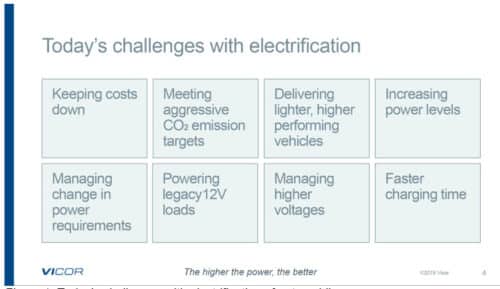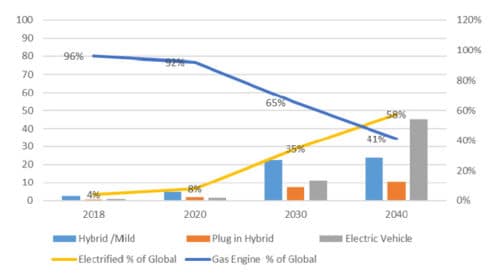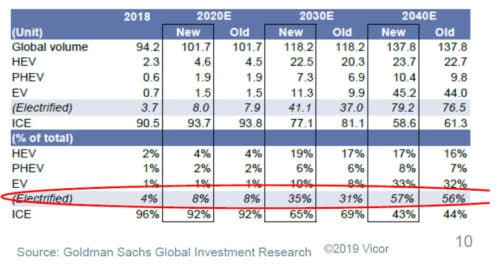 We heard that Vicor will soon be launching some innovative modules for the EV market. We decided to find out what they’re up to, by speaking to Patrick Wadden, who’s the Global Vice President for their Automotive Business. Here’s what we discovered…
We heard that Vicor will soon be launching some innovative modules for the EV market. We decided to find out what they’re up to, by speaking to Patrick Wadden, who’s the Global Vice President for their Automotive Business. Here’s what we discovered…
Q. What are the key challenges faced by engineers working on futuristic automobiles, which your proposed solutions aim to solve?
A. The key challenge we see OEMs facing today is the demand for smaller, lighter vehicles, requiring lower CO2 emissions. We aim to solve these through our next-generation power modules that deliver higher density and higher efficiency than other DC/DC converters.
Q. How many products are being launched in the automotive (EV and hybrid EV) space?
A. We have 8-10 products in our core product strategy. The key amongst them are (1) Ultra-high voltage to High Voltage (800V > 400) down to Low Voltage (400V > 48V), (2) Bi-directional Ultra-high to High (800V <> 400V), and (3) 12V/48V bidirectional.

Q. Can you also indicate for each product, the applications (trucks, EVs, hybrids, etc) for which they are best suited?
A. Our products and strategy will be ideally suited for hybrid, electric vehicle and plug-in hybrid. The high voltage to 48V will be suited for trucks, busses and 24-28V vehicles. And within those, our modules will be best-in-line for Powertrain and chassis systems, fast charging and powering 12/48v comfort loads.
Q. When do you expect these products be ready for trials, and when is mass-production expected?
A. We are providing samples to key customers right now, and aim to release auto-qualified products in the first half of 2021.
Q. If design engineers want to review your solutions for designs they are working on currently—is there any simulation or assistance that you offer?
A. Yes, we are producing demo boards and, in some cases, complete validated DC/DC converter enclosures for proof of concept and feasibility studies.
Q. For design engineers who want samples, do you supply them directly or can they buy from leading catalogue distributors?
A. Standard product samples can be ordered from Digi-Key, our core products for automotive are coordinated through our direct team.
Q. Why should your customers not look at designing their own modules themselves?
A. We achieve high power density, efficiency and thermal management through proprietary topologies and packaging. Additionally, we achieve automotive class quality and reliability through disciplined, automated manufacturing. It would be difficult to achieve automotive grade modules with the power density and efficiency of our partswithout access to our intellectual property and manufacturing.
Q. Any pricing indicators that you can share with our audience?
A. Pricing depends on a number of factors, including qualification requirements and an OEM’s implementation of the power delivery network using combinations of Vicor modules. Customers will realize considerable cost savings using a Vicor modular solution which reduces system costs and weight, downsizing connectors and wiring and harness

Q. What would be your message to Indian OEMs who are trying to decide between a Pure EV or a Hybrid EV strategy?
A. Figures 2 and 3 highlight the market trends. The EV market shows slower adoption, while Plug-in has benefits with convenience and real time Co2 emission savings. At the same time, HEV is expected to grow from 4% to 19% worldwide from 2020-2030.

Q. Will global certifications be apt for India, or will you need some local certifications too?
A. The India market may not be as demanding for certifications and automotive credentials; however, we would be able to offer both industrial versions and auto qualified versions depending on the requirements
Q. Can India expect your solutions to be available at the same time—as the rest of the globe? Or will there be a gradual roll-out?
A. Our level of engagement is based on working with OEM’s who want to partner with us early in the game and not necessarily decided by region or geography; we are working with OEMs and tier-ones who see the value in our solutions and want to improve overall system performance at the vehicle level.










Dear Sirs.
Please advise how to set up a diesel truck computer when adding a gas generator (H + H + O) to the fuel system.
We want to install this equipment on cars of any manufacturers. Maybe there is a standard technique?
Sincerely, Mark Tarasov